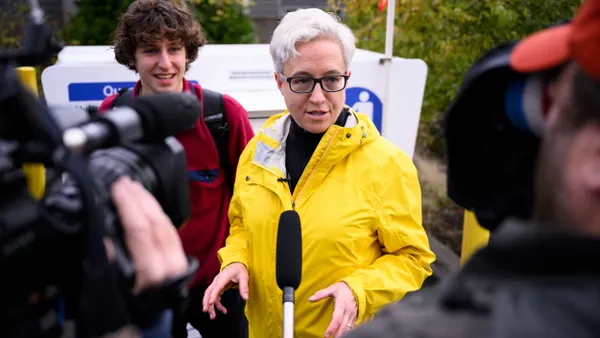Dive Brief:
-
Federal Energy Regulatory Commissioner Neil Chatterjee on Tuesday called on regional grid operators to design new market rules that allow batteries to provide grid services as part of a wide-ranging address on the future of energy storage.
-
Grid operators have grappled for years with how to design rules "particularly suited to storage," Chatterjee told an industry conference in Washington, but there has been "little momentum" in recent years on market products like frequency response that could allow batteries to grow.
-
Improving price points for batteries will allow storage, particularly paired with renewable energy, to grow quickly, Chatterjee said, but a number of regulatory uncertainties remain, like FERC's implementation of its landmark storage order and legal concerns over the commission's jurisdiction over distribution-connected storage.
Dive Insight:
Chatterjee's address at the Storage East conference shows how energy policymakers from both parties in Washington are embracing storage.
The Republican FERC regulator, appointed by President Donald Trump last year, noted that many of the nation's grid operators have planned new products for years that could allow batteries to provide essential grid services. But outside of PJM's Reg D product, a frequency regulation product that has come to be dominated by batteries, Chatterjee said action has been slow.
"For instance, several years ago [the Electric Reliability Council of Texas] chose not to move forward with a new suite of ancillary services products," he said. "Similarly, [the Midcontinent ISO] is considering the creation of a fast frequency product but has not moved forward with implementation, and [the California ISO] continues to study the need for a market based primary frequency response product."
Increasing amounts of renewable energy on the grid will help drive "additional momentum" for these efforts, Chatterjee said, "but, in any event, whether and how these products come to fruition will have a significant effect on opportunities for storage."
How wholesale market operators deal with recent FERC actions could provide other opportunities for storage, the commissioner said. Grid operators are currently preparing their implementation plans for FERC Order 841, approved in February, that mandated a level playing field for storage in wholesale markets.
"Because Order 841 provided high level requirements, the way each [grid operator] interprets those requirements could play a significant role in shaping the opportunities for storage in various regions," Chatterjee said.
Like the implementation plans, the timeline for FERC Order 841 remains unclear. Filings from grid operators are due Dec. 3, Chatterjee noted, and FERC is "likely to take several months" to evaluate them.
"If the commission finds that an RTO's filing is not up to snuff, sending it back for further revisions could result in several more months of delay before the changes are implemented," he said.
There could also be delays and uncertainty concerning Order 841 itself. A number of states and grid operators, including MISO, have filed for rehearing on the order, questioning FERC's jurisdiction over distribution-connected energy storage. Similar issues are at play in debates over FERC's treatment of aggregated distributed energy resources, the subject of a commission technical conference this spring.
Chatterjee did not indicate when FERC may rule on the Order 841 rehearing request, but once it does, "parties can seek review in the court of appeals," he said.
Despite those multiple uncertainties, Chatterjee was optimistic about the future of storage, particularly sited with renewable energy.
"Co-located storage with renewables certainly has benefits, but is co-locating renewables with storage going to become standard practice? The answer to that question could have major implications for storage," he said. "We have evidence that the cost-benefit ratio of co-located storage is tipping in favor of adding storage."
The FERC regulator highlighted a 2017 resource solicitation from Xcel Colorado that delivered eye-popping prices for both stand-alone renewables and resources sited with batteries.
"Wind and solar co-located with battery storage had median offers of $21/MWh and $36/MWh, respectively," Chatterjee noted. "That's only a $3/MWh and $7/MWh premium over conventional wind and solar."
New reliability requirements for generators in wholesale power markets could make it more attractive for renewable energy developers to add batteries, along with FERC Order 845, approved in April, which mandates all generators be capable of providing essential grid services.
"When you consider market incentives like pay for performance, capacity constructs in PJM and ISO-NE, co-location could be extremely beneficial in allowing renewables to avoid performance penalties and take advantage of high prices," Chatterjee said.
Pending issues before FERC could also affect the viability of co-located storage in states outside of wholesale power markets.
This summer, Montana utility Northwestern Energy asked FERC to repeal special "qualifying facility" status under the Public Utility Regulatory Policies Act (PURPA) for four wind-plus-battery systems a developer is trying to install in its service area.
The case could shape how FERC treats paired storage facilities under PURPA, which compels utilities to purchase power from small renewable energy producers. If it denies Northwestern's petition, such resources could gain a stronger foothold in states that still retain the vertically integrated utility model.
The Northwestern case comes as FERC undertakes a broad review of how it implements PURPA, and the Edison Electric Institute, a utility trade group, has asked the regulators to put the Montana case on hold until that review is complete.
Chatterjee did not address the Montana case or PURPA review in his speech, and his staff said he could not comment on the pending proceedings. Late last month, however, he told Utility Dive the review is still in its early stages.
"The way the commission processes work is staff puts together an options memo that lays out what the available options are and we're just waiting on that memo," Chatterjee said. "On what form it will take or what timeline it will take, we don't have any clarity on that yet."













